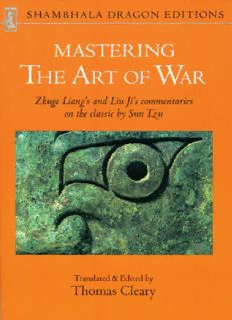
Mastering the art of war PDF
Preview Mastering the art of war
ABOUT THE BOOK Composed by two prominent statesmen-generals of classical China, this book develops the strategies of Sun Tzu’s classic, The Art of War, into a complete handbook of organization and leadership. The great leaders of ancient China who were trained in Sun Tzu’s principles understood how war is waged successfully, both materially and mentally, and how victory and defeat follow clear social, psychological, and environmental laws. Drawing on episodes from the panorama of Chinese history, Mastering the Art of War presents practical summaries of these essential laws along with tales of conflict and strategy that show in concrete terms the proper use of Sun Tzu’s principles. The book also examines the social and psychological aspects of organization and crisis management. The translator’s introduction surveys the Chinese philosophies of war and conflict and explores in depth the parallels between The Art of War and the oldest handbook of strategic living, the I Ching (Book of Changes). THOMAS CLEARY holds a PhD in East Asian Languages and Civilizations from Harvard University and a JD from the University of California, Berkeley, Boalt Hall School of Law. He is the translator of over fifty volumes of Buddhist, Taoist, Confucian, and Islamic texts from Sanskrit, Chinese, Japanese, Pali, and Arabic. Sign up to learn more about our books and receive special offers from Shambhala Publications. Or visit us online to sign up at shambhala.com/eshambhala. Mastering the Art of War Z L & L J HUGE IANG IU I TRANSLATED AND EDITED BY Thomas Cleary SHAMBHALA Boston & London 2013 SHAMBHALA PUBLICATIONS, INC. Horticultural Hall 300 Massachusetts Avenue Boston, Massachusetts 02115 www.shambhala.com © 1989, 2000 by Thomas Cleary All rights reserved. No part of this book may be reproduced in any form or by any means, electronic or mechanical, including photocopying, recording, or by any information storage and retrieval system, without permission in writing from the publisher. The Library of Congress catalogues the previous edition of this work as follows: Mastering the art of war. 1. Sun-tzu, 6th cent. B.C. Sun tzu ping fa. 2. Military art and science. I. Chuko, Liang, 181–234. II. Liu, Chi, 1311–1375. III. Cleary, Thomas F., 1949– eISBN 978-0-83482481-2 ISBN 978-0-87773-513-7 (paperback) ISBN 978-1-59030-264-4 (Shambhala Library) U101.S96M37 1989 355.02 89-10264 CONTENTS Note on Pronunciation Translator’s Introduction The Art of War and the I Ching: Strategy and Change Notes on Sources PART ONE The Way of the General: Essays on Leadership and Crisis Management by Zhuge Liang Translator’s Introduction The Way of the General The Authority of the Military Leadership Chasing Evils Knowing People Types of Generals Capacities of Commanders Decadence in Generals Loyalty in Generals Skills of Generals Arrogance in Generals Military Preparedness Training Corruption in the Armed Forces Loyal Hearts Careful Watching Formation of Opportunity Good Generalship Discerning Bases Victory and Defeat Using Authority Grieving for the Dead Allies Responsiveness Taking Opportunities Assessing Abilities Facilitating Battle Striking Power Psychological Configurations Orderly Troops Inspiring Soldiers Self-Exertion Harmonizing People The Condition of a General Order and Disorder Observant Government Rulers and Ministers Knowledgeable Rule Not Knowing Adjudication Disturbance and Security Appointments Pillars of State Evaluation and Dismissal What Hurts the People Military Action Rewards and Penalties Clarity and Consistency Pleasure and Displeasure Culture and the Military Organization Instruction and Direction Thought and Consideration Strength in Generals Sending Out the Armed Forces Selection on Abilities The Use of Knowledge Not Setting Up Battle Lines Sincerity in Generals PART TWO Lessons of War: Studies in Strategy by Liu Ji Translator’s Introduction Chronology of Historical Periods in Liu Ji’s Tales Lessons of War Calculated Battle Fighting Schemes Espionage and Warfare Elite Fighters Battling on Good Faith Instruction and Warfare Caring in War Authority and Warfare Reward and Battle Punishment and Battle Defensive Battle Offensive Battle Strength and Battle Weakness and Battle Hauteur and Battle Diplomatic Relations Formation and Battle Momentum and Battle Knowledge and Battle Reconnaissance Striving in Battle Going on the Attack Defense and Battle Postponing Battle Emptiness in Battle Battling with the Full Fighting Too Readily Using Profit to Fight Fighting Attackers Fearlessness in Danger Hunger and Battle Fighting on Full Stomachs Fatigue and Battle Victory in Battle Defeat in Battle Taking the Initiative Provocation and Battle Slow-Paced Battle Swift Battle Orderliness and Battle Energy and Battle Fighting on the Way Home Pursuit and Battle Not Fighting Avoiding Battle Surrounding Enemies Surrender Hardship Easy Battle Battle in Extremity Warring in Accord with Nature Health and Warfare E-mail Sign-Up NOTE ON PRONUNCIATION The Chinese proper names in this book are transliterated in Pinyin, the most widely accepted method of romanization for Chinese. In actual usage, Chinese phonetics are so complex that a detailed treatment of Chinese pronunciation is outside the scope of this book. For the comfort and ease of the reader, however, it is useful to note a few letters that are commonly used in Pinyin spelling but are relatively uncommon in English and are given different values. There are five consonants that are typically found to cause problems because of their special usage: c, q, x, z, and zh. The following chart represents rough equivalents to these consonants in English: c resembles ts q resembles ch x resembles sh z resembles dz zh resembles j
Description: